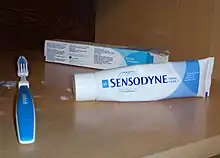 Sensodyne twin sachet (in the Philippines) | |
| Product type | Toothpaste |
|---|---|
| Owner | Haleon |
| Country | United States |
| Introduced | 1961 |
| Related brands | Aquafresh Biotene |
| Markets | Worldwide |
| Previous owners | |
| Website | www |
Sensodyne is a brand name of toothpaste and mouthwash targeted at people with sensitive teeth.[1] Sensodyne is owned by Haleon and is marketed under the name Shumitect in Japan.[2]
Effectiveness
Sensodyne toothpastes work in different ways depending on the product's active ingredient—potassium nitrate, strontium acetate/chloride.
Potassium nitrate: The potassium ion hyperpolarizes[3] the nerve and stops it from firing. The nerve impulses are thus desensitized and there is no pain.
Strontium acetate and strontium chloride: These compounds share a similar chemical structure to calcium. Strontium based toothpastes (acetate and chloride) are therefore able to replace some of the lost calcium and block the exposed tubules in the dentinal tissue. This helps prevent the movement of the fluid within the tubules in response to a sensitivity stimulus that could otherwise cause tooth pain.[4]
Some Sensodyne products contain calcium sodium phosphosilicate CSPS (Novamin), which appears to help with tooth sensitivity.[5][6] A randomized clinical trial published in 2015 demonstrated that dentifrices containing 5% CSPS may have the potential to mineralize and occlude the dentine in the oral environment.[7][8] Sensodyne products sold in the United States do not contain calcium sodium phosphosilicate (Novamin).[9]
History
Sensodyne is a brand of toothpaste that was first sold by Block Drug, a Brooklyn, New York-based company established in 1907 by pharmacist Alexander Block.[1]
By 1925, manufacturing dental care products had become the company's focus. Leonard N. Block followed his father into the family business which relocated to Jersey City, New Jersey, in 1938.[10]
In 2000, Block Drug was purchased by Smith Kline Beecham P.L.C.,[11] which became GlaxoSmithKline (NYSE:GSK).[12]
The toothpaste was first marketed in 1961 as a desensitising toothpaste based on a strontium chloride formulation. In 1980, Sensodyne launched a new toothpaste containing potassium nitrate, a mild local sedative.[13]
Sensodyne became a part of Haleon, a British multinational consumer healthcare corporation, in July 2022, following the establishment of Haleon as a separate entity through a corporate spin-off from GSK.[14]
Product counterfeits and recall
In 2007, GlaxoSmithKline tracked down counterfeit producers of Sensodyne after a consumer in Panama noted diethylene glycol, a poisonous ingredient commonly found in antifreeze, on the label of his toothpaste.[15]
On July 15, 2015, GlaxoSmithKline Consumer Healthcare announced a recall of certain lots of Sensodyne Repair & Protect toothpaste as well as Sensodyne Complete toothpaste due to the possible presence of wood fragments in the products. The recall also applied to the company's Biotene brand of toothpaste. The recall was a precautionary measure based on a small number of complaints, and no injuries have been reported. The recall applies to products manufactured between 2013 and September 2014, and shipped from June 2013 to April 2015.[16]
See also
References
- 1 2 Clark, Andrew (October 7, 2000). "SmithKline to swallow Sensodyne". The Guardian. Retrieved July 20, 2013.
- ↑ "Sensodyne | Our consumer healthcare products | Products | GlaxoSmithKline". Archived from the original on 2013-03-05. Retrieved 2013-03-17.
- ↑ Walsh, Margaret (Apr 15, 2014). Dental Hygiene: Theory and Practice. Elsevier Health Sciences. p. 699. ISBN 9781455745845.
- ↑ Hughes, N; Layer, T (2010). "Evidence for the efficacy of an 8% strontium acetate dentifrice for instant and lasting relief of dentin hypersensitivity". Journal of Clinical Dentistry. 21 (5): 56–58. PMID 20669817.
- ↑ Freda, Nicolas M; Veitz-Keenan, Analia (March 2016). "Calcium sodium phosphosilicate had some benefit on dentine hypersensitivity: Question: Is calcium sodium phosphosilicate (CSPS) effective in reducing dentine hypersensitivity (DH) pain response?". Evidence-Based Dentistry. 17 (1): 12–13. doi:10.1038/sj.ebd.6401148. PMID 27012568. S2CID 24049298.
- ↑ Goldie, Maria (15 March 2011). "Potassium nitrate, sodium fluoride, strontium chloride, and NovaMin technologies for dentin hypersensitivity". Dentistry IQ. Retrieved 21 November 2014.
- ↑ Jones, Siân Bodfel; Parkinson, Charles R.; Jeffery, Peter; Davies, Maria; Macdonald, Emma L.; Seong, Joon; West, Nicola X. (June 2015). "A randomised clinical trial investigating calcium sodium phosphosilicate as a dentine mineralising agent in the oral environment". Journal of Dentistry. 43 (6): 757–764. doi:10.1016/j.jdent.2014.10.005. PMID 25456613.
- ↑ Hall, Claire; Mason, Stephen; Cooke, Jonathan (May 2017). "Exploratory randomised controlled clinical study to evaluate the comparative efficacy of two occluding toothpastes – a 5% calcium sodium phosphosilicate toothpaste and an 8% arginine/calcium carbonate toothpaste – for the longer-term relief of dentine hypersensitivity". Journal of Dentistry. 60: 36–43. doi:10.1016/j.jdent.2017.02.009. PMID 28219674.
- ↑ United States National Institutes of Health, National Library of Medicine, SENSODYNE REPAIR AND PROTECT – stannous fluoride paste.
- ↑ Saxon, Wolfgang (2005-11-12). "Leonard Block, 93, Chief of Drug Company, Is Dead". The New York Times. ISSN 0362-4331. Retrieved 2019-09-30.
- ↑ "Company News; Smithkline to Buy Block Drug for $1.2 Billion". The New York Times. 2000-10-10. ISSN 0362-4331. Retrieved 2019-09-30.
- ↑ "Firms Complete Merger of GlaxoSmithKline". Los Angeles Times. 2000-12-28. Retrieved 2019-09-30.
- ↑ Ramirez, Anthony (May 13, 1990). "All About/Toothpaste; Growth Is Glacial, but the Market Is Big, and So Is the Gross". The New York Times. Retrieved July 20, 2013.
- ↑ Khalaf, Roula (5 May 2023). "Healthy return proves worth of Haleon spin-out". Financial Times. Retrieved 23 November 2023.
- ↑ Colgate and Sensodyne, got caught up in the sweep when counterfeiters were found to be selling toothpaste with antifreeze under their names. BOGDANICH, WALT (October 1, 2007). "The Everyman Who Exposed Tainted Toothpaste". The New York Times. Retrieved 2 April 2019.
- ↑ "Urgent: Product Recall – Retail Level" (PDF). Smith Drug. 15 July 2015.